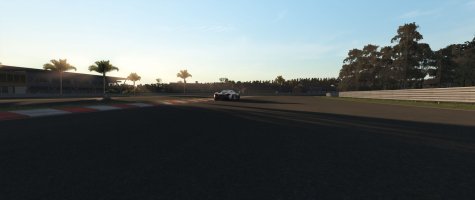
Inverted FFB:
Enable it if your wheel pulls in the wrong direction.
FFB Intensity:
Adjusts the overall strength.
Smoothing:
Filters out peaks in the FFB, for example when driving over big kerbs.
Increase it if you think your wheel makes too much noise over kerbs.
Decrease it if you think the FFB feels washed out.
Recommended setting: between 0 - 50%

Steering Force Intensity:
Adjusts the forces generated from cornering.
Increase it to make the wheel stiffer and to get more feedback when the car is oversteering.
Decrease it if you experience clipping.
Recommended setting: between 100 - 150%
Understeer:
Controls how light the wheel will get when understeering.
Decrease if you loose force too quickly when entering a corner.
Increase if you can´t feel the grip loss when entering a corner.
Recommended setting: between 50 - 100%
Vertical Load:

Controls how strong vertical forces on the tyres are reflected in the FFB.
Mostly used to feel bumps on the road.
Increase to feel more details of the driving surface.
Decrease if bumps are too strong.
Recommended setting: between 100 - 200%
Lateral Force:

Controls how strong lateral forces on the tyres are reflected in the FFB.
Increase to make the wheel stiffer.
Decrease if the FFB looses too much detail (clipping).
Recommended setting: Between 25 - 75 %
Steering Rack:
Choose how much of the lateral forces are calculated using the steering rack of the car instead of the tyres.
Recommended setting: Personal preference

Engine Vibrations:
Intensity of vibrations generated by the engine of the car
Decrease if there is too much noise in the FFB
Increase to get more feedback from the engine.
Kerb Vibrations:
Adjust the amount of vibrations resulting from rumble strips (2D kerbs)
This setting does not affect forces coming from 3D kerbs (use vertical load & smoothing to adjust that).
Shift Effect:
Adjusts how strong the kick from shifting is.
FFB Meter
In the secondary controller settings you will find an option to bind a key for the FFB Meter.
Once enabled, the yellow line marks your minimum force setting, and the red line shows the maximum force.
The green graph displays the steering forces sent to your wheel.
If the graph exceeds the red line you are experiencing "Clipping"
Clipping means, that your wheel has reached the maximum output force and you won't feel any difference above that limit.

Minimum Force
The minimum Force Setting can be found in the FFB Settings Menu, and will allow you to amplify all the small FFB forces that your wheel might not be able to put out. That means small bumps and steering forces will be increased to a point where you can actually feel them through your wheel and thereby adding more details to your FFB.
This will also help eliminate the "dead center feeling" occurring with some of the wheels.

Slip Effect
This Effect simulates the shuttering of your tires as they struggle for grip,
which occurs for example during wheelspin, understeering, sliding and even on heavy braking.
Depending on the amount of grip as well as the rotation speed of your tires you will feel a vibration indicating that your tires are slipping.
The higher the rotation speed of your tires, the higher the frequency of the vibrations is.
The more grip your tires loose, the higher the amplitude of the vibration will be.

Stationary Friction
This will deal with the problem of wheels rotating by themselves if the car is stationary, for example in garage or on the starting grid.
This won't be an option you will find in the menu, and it only takes effect, if the car moves slower then a couple of meter per second.
FFB Multiplier
Since the FFB in R3E is based on the car physics (Tire load & grip + suspension geometry), different cars result in different FFB strength.
So in the past you might have found your perfect FFB settings for one car, only to find out they don't work as well with another car.
To avoid this, you are now able to adjust the cars individual FFB strength by changing the FFB Multiplier.
You will find this new Setting in the Car Setup>Steering Settings.
Increase the FFB Multiplier if a particular car feels too weak.
Decrease it, if the FFB of the car is causing heavy clipping.

Recommended Settings
1. Start by choosing the new default profile for your wheel in the Controller Profiles Menu. It contains presets for all the new settings.
2. To adjust the FFB strength individually per car, change the FFB Multiplier in the Car Setup>Steering Settings Menu
3. Depending on the Wheel you own, choose how much Clipping you want to allow.
- If you for example own a Logitech G27, you should aim for Mild Clipping values, in order not to loose too much of the overall FFB Strength.
- If you own a high end, direct driven wheel you can easily set it up for Zero Clipping, for the maximum amount of detail.











